Coding challenges
Starting with v12.9.0, OWASP Juice Shop offers a new developer-focused challenge for
some of its existing hacking challenges: Coding challenges. These were briefly illustrated in Part 1 of this book
from a user's perspective. This appendix explains how a coding challenge can be added
to newly created hacking challenges.
Each coding challenge consists of two phases:
- Find It where the user is tasked to select vulnerable line(s) of code in an actual code snippet from Juice Shop
- Fix It where the user is presented with 3-4 options to choose from to fix that vulnerability and has to decide which one would be the best
Vulnerable code snippets
Juice Shop allows associating its own vulnerable code with its own hacking challenges. To outfit new challenges with such a code snippet, some conditions must be met, and a certain syntax for marking the code snippet have to be used.
Supported source files
Juice Shop will perform a lookup for code snippets in these source files or folders:
./server.ts
./routes
./lib
./data
./frontend/src/app
These are equally available when cloning the source code repo, running the official Docker image or unpacking an official pre-packaged archive.
vuln-code-snippet marker comments
All marker comments relevant for the code snippet processing start with
the vuln-code-snippet prefix followed by the type of marker, often
followed by the challenge key(s) the marker should be applied to.
| Marker Type | Challenge Key(s) | Description | Example |
|---|---|---|---|
start |
Yes | Beginning of a snippet for one or more challenges. | // vuln-code-snippet start localXssChallenge xssBonusChallenge |
end |
Yes | End of a snippet for one or more challenges. | // vuln-code-snippet end localXssChallenge xssBonusChallenge |
vuln-line |
Yes | Vulnerable code line for one or more challenges. Can appear multiple times within a corresponding start-end block. |
// vuln-code-snippet vuln-line localXssChallenge xssBonusChallenge |
neutral-line |
Yes | Code line for one or more challenges with no impact on verdict if selected. Can appear multiple times within a corresponding start-end block. |
// vuln-code-snippet neutral-line adminSectionChallenge |
hide-line |
No | That particular line will be removed from all code snippets. | // vuln-code-snippet hide-line |
hide-start |
No | Beginning of a block that will be removed from all code snippets. | // vuln-code-snippet hide-start |
hide-end |
No | End of a block that will be removed from all code snippets. | // vuln-code-snippet hide-end |
Code snippet markers are recognized in any files as long as they support
a leading // or # for a single-line comment. This makes them usable
in TypeScript, JavaScript and YAML files, but not in HTML. Code markers
are only found in files residing in one of the above-mentioned folders.
Complete examples
TypeScript
The following code shows markers for two challenges with the same vulnerable line, and a hidden code block:
// vuln-code-snippet start localXssChallenge xssBonusChallenge
filterTable () {
let queryParam: string = this.route.snapshot.queryParams.q
if (queryParam) {
queryParam = queryParam.trim()
this.ngZone.runOutsideAngular(() => { // vuln-code-snippet hide-start
this.io.socket().emit('verifyLocalXssChallenge', queryParam)
}) // vuln-code-snippet hide-end
this.dataSource.filter = queryParam.toLowerCase()
this.searchValue = this.sanitizer.bypassSecurityTrustHtml(queryParam) // vuln-code-snippet vuln-line localXssChallenge xssBonusChallenge
this.gridDataSource.subscribe((result: any) => {
if (result.length === 0) {
this.emptyState = true
} else {
this.emptyState = false
}
})
} else {
this.dataSource.filter = ''
this.searchValue = undefined
this.emptyState = false
}
}
// vuln-code-snippet end localXssChallenge xssBonusChallenge
The next example explains how to mark one challenge with two vulnerable lines, and some individually hidden lines:
// vuln-code-snippet start fileWriteChallenge
function handleZipFileUpload ({ file }, res, next) {
if (utils.endsWith(file.originalname.toLowerCase(), '.zip')) {
if (file.buffer && !utils.disableOnContainerEnv()) { // vuln-code-snippet hide-line
const buffer = file.buffer
const filename = file.originalname.toLowerCase()
const tempFile = path.join(os.tmpdir(), filename)
fs.open(tempFile, 'w', function (err, fd) {
if (err != null) { next(err) }
fs.write(fd, buffer, 0, buffer.length, null, function (err) {
if (err != null) { next(err) }
fs.close(fd, function () {
fs.createReadStream(tempFile)
.pipe(unzipper.Parse()) // vuln-code-snippet vuln-line fileWriteChallenge
.on('entry', function (entry) {
const fileName = entry.path
const absolutePath = path.resolve('uploads/complaints/' + fileName)
utils.solveIf(challenges.fileWriteChallenge, () => { return absolutePath === path.resolve('ftp/legal.md') }) // vuln-code-snippet hide-line
if (absolutePath.includes(path.resolve('.'))) {
entry.pipe(fs.createWriteStream('uploads/complaints/' + fileName).on('error', function (err) { next(err) })) // vuln-code-snippet vuln-line fileWriteChallenge
} else {
entry.autodrain()
}
}).on('error', function (err) { next(err) })
})
})
})
} // vuln-code-snippet hide-line
res.status(204).end()
} else {
next()
}
}
// vuln-code-snippet end fileWriteChallenge
YAML
In this example, multiple challenges are defined in a shared code block but each with their own vulnerable line. Each also comes with a neutral line that would have no impact on the verdict if selected or not by the user:
# vuln-code-snippet start resetPasswordBjoernOwaspChallenge resetPasswordBjoernChallenge resetPasswordJimChallenge resetPasswordBenderChallenge resetPasswordUvoginChallenge
- # vuln-code-snippet neutral-line resetPasswordJimChallenge
question: 'Your eldest siblings middle name?' # vuln-code-snippet vuln-line resetPasswordJimChallenge
-
question: "Mother's maiden name?"
-
question: "Mother's birth date? (MM/DD/YY)"
-
question: "Father's birth date? (MM/DD/YY)"
-
question: "Maternal grandmother's first name?"
-
question: "Paternal grandmother's first name?"
- # vuln-code-snippet neutral-line resetPasswordBjoernOwaspChallenge
question: 'Name of your favorite pet?' # vuln-code-snippet vuln-line resetPasswordBjoernOwaspChallenge
-
question: "Last name of dentist when you were a teenager? (Do not include 'Dr.')"
- # vuln-code-snippet neutral-line resetPasswordBjoernChallenge
question: 'Your ZIP/postal code when you were a teenager?' # vuln-code-snippet vuln-line resetPasswordBjoernChallenge
- # vuln-code-snippet neutral-line resetPasswordBenderChallenge
question: 'Company you first work for as an adult?' # vuln-code-snippet vuln-line resetPasswordBenderChallenge
-
question: 'Your favorite book?'
- # vuln-code-snippet neutral-line resetPasswordUvoginChallenge
question: 'Your favorite movie?' # vuln-code-snippet vuln-line resetPasswordUvoginChallenge
-
question: 'Number of one of your customer or ID cards?'
-
question: "What's your favorite place to go hiking?"
# vuln-code-snippet end resetPasswordBjoernOwaspChallenge resetPasswordBjoernChallenge resetPasswordJimChallenge resetPasswordBenderChallenge resetPasswordUvoginChallenge
Overlapping markers
After a code snippet has been retrieved and processed, all "dangling"
markers inside starting with vuln-code-snippet will be removed. This
allows to have overlapping start and end blocks for different
challenges that might share some but not all code.
REST endpoints
The Score Board retrieves the actual code snippets via two REST endpoints:
/snippetsreturns the list of all challenge keys where code snippets are available in JSON format (e.g.{"challenges":["directoryListingChallenge",...,"xssBonusChallenge"]})/snippets/<challengeKey>returns the actual code snippet plus the list of vulnerable lines in JSON format (e.g.{"snippet":"filterTable () {\n let queryParam: string = ... }\n }","vulnLines":[6]})
Error handling
The following errors can occur when calling the REST endpoints:
| Endpoint | HTTP status code | Error |
|---|---|---|
/snippets/<challengeKey> |
412 |
Unknown challenge key: <challengeKey> |
/snippets/<challengeKey> |
404 |
No code snippet available for: <challengeKey> |
/snippets/<challengeKey> |
422 |
Broken code snippet boundaries for: <challengeKey> |
Real-time retrieval
As the code snippets are retrieved in real-time from the actual code base, all changes to the marker syntax while the application is running are immediately applied and can be tested by re-opening the particular snippet from the Score Board. Newly added code snippets are similarly recognized by reloading the Score Board page. No frontend complation or server restart is required.
Fix option files
For the second stage of the Coding Challenges, users must by supplied with some code fix options to choose from. The structural requirements here are very straightforward, it is rather the content that can get a bit difficult depending on the complexity of the underlying vulnerability.
All fix option files have to be put into the folder data/static/codefixes and should have the same
file type as the original source file with the vulnerability marker.
For each coding challenge exactly one "correct" and two or more "wrong" option files must be provided.
Naming conventions
The name of a fix option file must be either of the following:
<challengeKey>_<unique number>.<file suffix>for "wrong" options- e.g.
localXssChallenge_1.ts,localXssChallenge_3.tsandlocalXssChallenge_4.ts
- e.g.
<challengeKey>_<unique number>_correct.<file suffix>for the "correct" option- e.g.
localXssChallenge_2_correct.ts
- e.g.
Fix option source
As the Coding Challenges rely on a code diff view it is crucial to avoid any accidental differences between the original vulnerable code snippet and each fix option files.
This means that spacing, blank lines etc. need to be exactly the same. If for example the vulnerable
snippet is in a function that is indented by 4 spaces then the fix option source must be indented by 4 spaces as well.
As this would trigger many code linting errors, npm run lint will ignore the data/static/codefixes folder.
The following additional rules must be adhered to when creating fix option files:
- No indentation on the first line of the file
- No blank line at the end of the file
- Remove all
vuln-code-snippetcomments in the exact same way the code snipper parser will
The recommended way to get properly formatted code fixing options, is to create one and copy it as many times as total fix options should be provided, then performing the necessary changes to create a correct and several wrong options from the source.
Vulnerable code snippet example
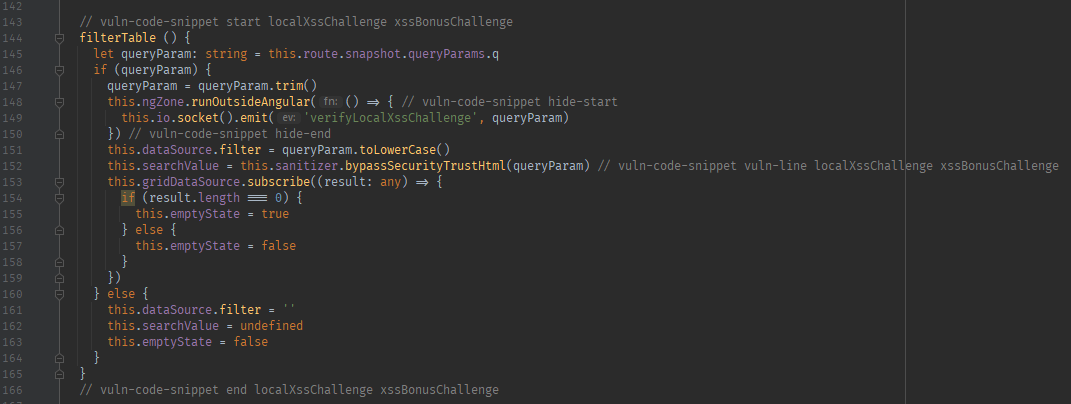
Wrong fix option example
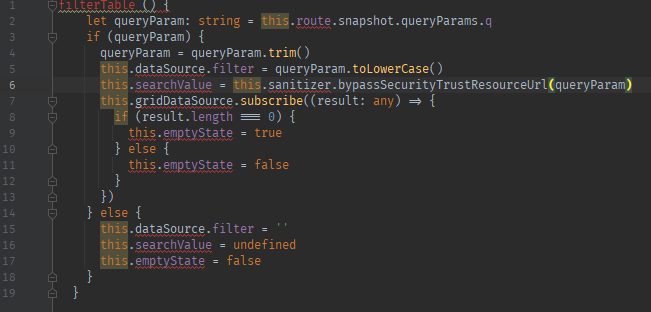
Correct fix option example
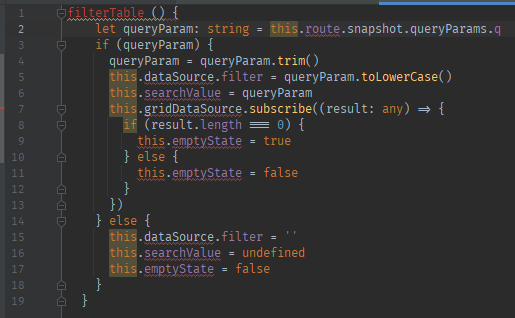
Maintenance burden
The downside of this implementation is a certain maintenance burden for Coding Challenges. When the original source file is changed or refactored, the developer must keep in mind updating all fix option files accordingly to prevent confusing differences.
Refactoring Safety Net
Starting with v13.2.0, the maintenance burden is eased by a utility that detects many (but not all) accidental or
forgotten code changes in fix option files or the original code snippet that made them deviate from each other. It runs
automatically as a job of the CI/CD pipeline but can also be launched locally
with npm run rsn.
If no unexpected changes occured to any lines of code in either the original snippet or any corresponding fix option files
occured, npm run rsn will produce a list of all current differences and a success message:
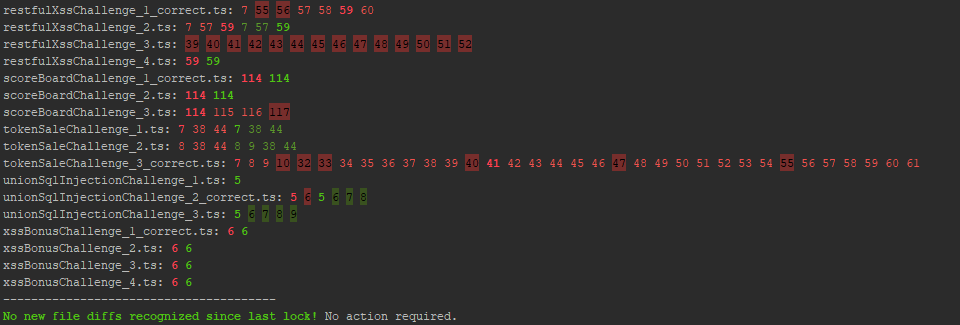
If instead some unexpected file differences came up, the tool will still print the list of current differences as well as a list of the affected files and terminate with an error.
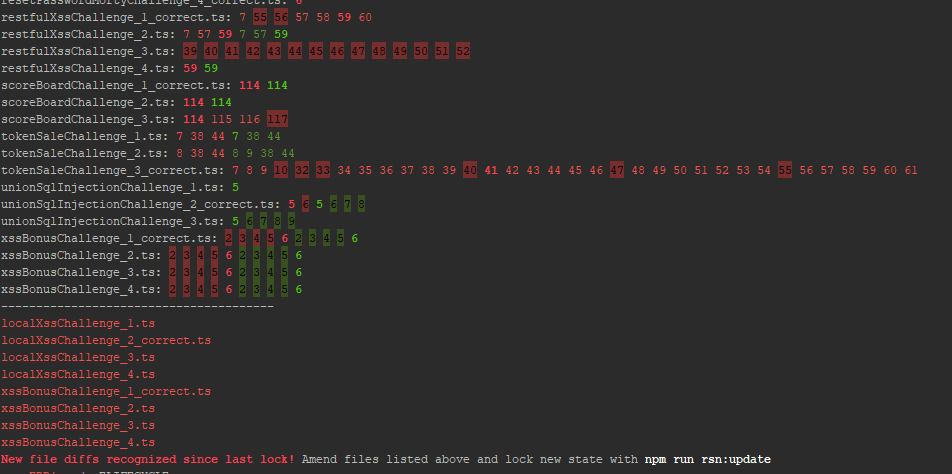
The author of the code change that broke the RSN check can now investigate the reason for the new differences either in the
Coding Challenge dialog of the running application or by comparing the source code files.
After either reverting any accidental changes in e.g. indentation or simply re-applying refactorings (e.g. parameters or functions being
renamed) to the missed piece of code, running npm run rsn:update will lock the new state of
differences in place.
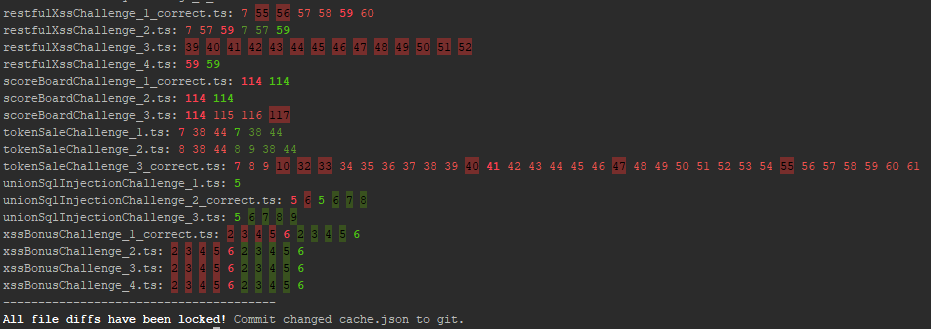
Any subsequent run of npm run rsn will now succeed again, until another accidental difference occurs.
Limitations
As the RSN utility checks and caches differences on a per-line level, accidental changes to lines which are already expected
to be different, will not trigger a failure of npm run rsn. This should be very rare coincidence in daily development on the
project, so the Juice Shop team rather accepts the small risk instead of overengineering the RSN to catch those edge cases.
Info YAML file
It is possible to provide hints and explanations for Coding Challenges via an optional YAML file. It needs
to follow the naming convention <challengeKey>.info.yml and be placed in data/static/codefixes. This file can
contain the following:
fixes:
- id: 1
explanation: 'Explanation why fix option file #1 is right/wrong.'
- id: 2
explanation: 'Explanation why fix option file #2 is right/wrong.'
- id: 3
explanation: 'Explanation why fix option file #3 is right/wrong.'
- id: 4
explanation: 'Explanation why fix option file #4 is right/wrong.'
hints:
- "Hint offered after 2nd failed 'Find It' attempt to submit the vulnerable line."
- "Hint offered after 3nd failed 'Find It' attempt to submit the vulnerable line."
- "Hint offered after 4th failed 'Find It' attempt to submit the vulnerable line."
"Find It" hints
When the user submits wrongly selected vulnerable line(s) of code during the "Find It" phase of a Coding Challenge, Juice Shop can display a hint to help them out. This process starts after the second failed submission.
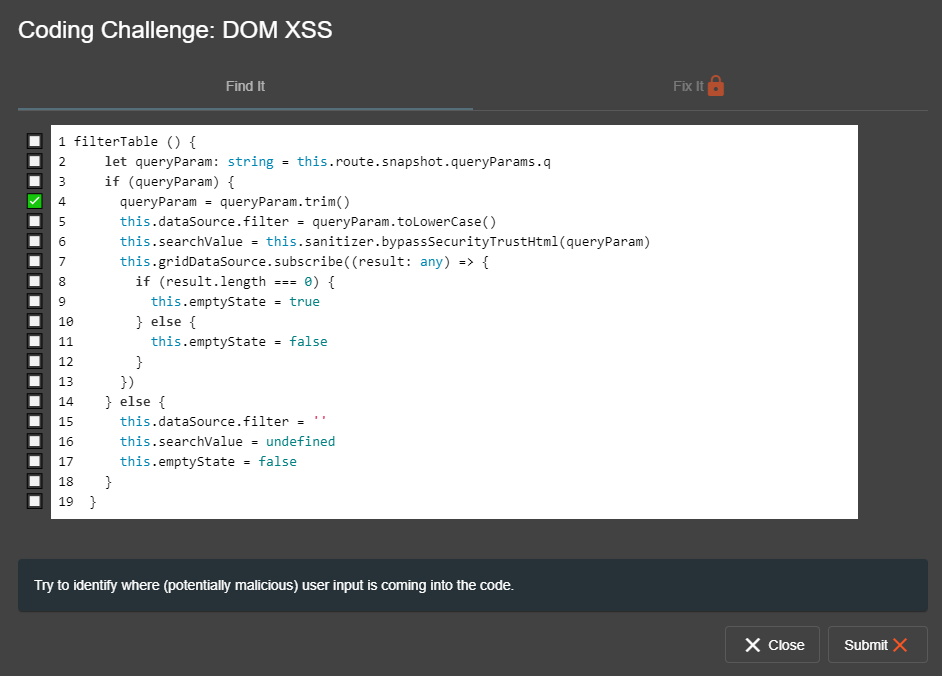
The hints will be picked in order of appearance in the hints list of the YAML info file.
One hint will be displayed at a time per submission attempt. It therefore makes sense to
have more vague hints at the top and more specific ones at the bottom of the hints list.
Although the number of hints that can be provided per coding challenge is not restricted,
the author recommends to have no less than 2 and no more than 5 hints on average.


Once all hints have been used up, Juice Shop will outright tell the user the correct answer, so they have a chance to proceed and not remain stuck infinitely.
This answer does not need to be provided in the hints list, as it will be generated on-the-fly by Juice Shop when needed.

"Fix It" explanations
In the fixes list an explanation can be mapped to every available fix option of a Coding Challenge.
The id must be identical to the unique nuber part of a fix option file name <challengeKey>_<unique number>.<file suffix> in order to be loaded when appropriate.
The explanation should give a reason as to why a fix option is either correct or incorrect. The
explanation will be displayed after the user submitted a chosen fix option.

Other than with the hints for finding the vulnerable line of code, the explanation is displayed independently of the verdict. Therefore, it is important to also provide an explanation for the correct fix option.
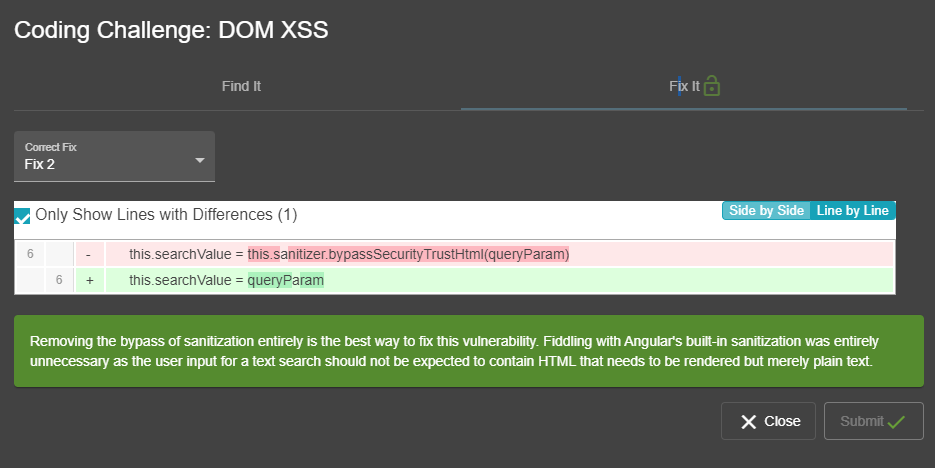
Info YAML file example
fixes:
- id: 1
explanation: 'Using bypassSecurityTrustResourceUrl() instead of bypassSecurityTrustHtml() changes the context for which input sanitization is bypassed. This switch might only accidentally keep XSS prevention intact, but the new URL context does not make any sense here.'
- id: 2
explanation: "Removing the bypass of sanitization entirely is the best way to fix this vulnerability. Fiddling with Angular's built-in sanitization was entirely unnecessary as the user input for a text search should not be expected to contain HTML that needs to be rendered but merely plain text."
- id: 3
explanation: 'Using bypassSecurityTrustScript() instead of bypassSecurityTrustHtml() changes the context for which input sanitization is bypassed. If at all, this switch might only accidentally keep XSS prevention intact. The context where the parameter is used is not a script either, so this switch would be nonsensical.'
- id: 4
explanation: 'Using bypassSecurityTrustStyle() instead of bypassSecurityTrustHtml() changes the context for which input sanitization is bypassed. If at all, this switch might only accidentally keep XSS prevention intact. The context where the parameter is used is not CSS, making this switch totally pointless.'
hints:
- "Try to identify where (potentially malicious) user input is coming into the code."
- "What is the code doing with the user input other than using it to filter the data source?"
- "Look for a line where the developers fiddled with Angular's built-in security model."